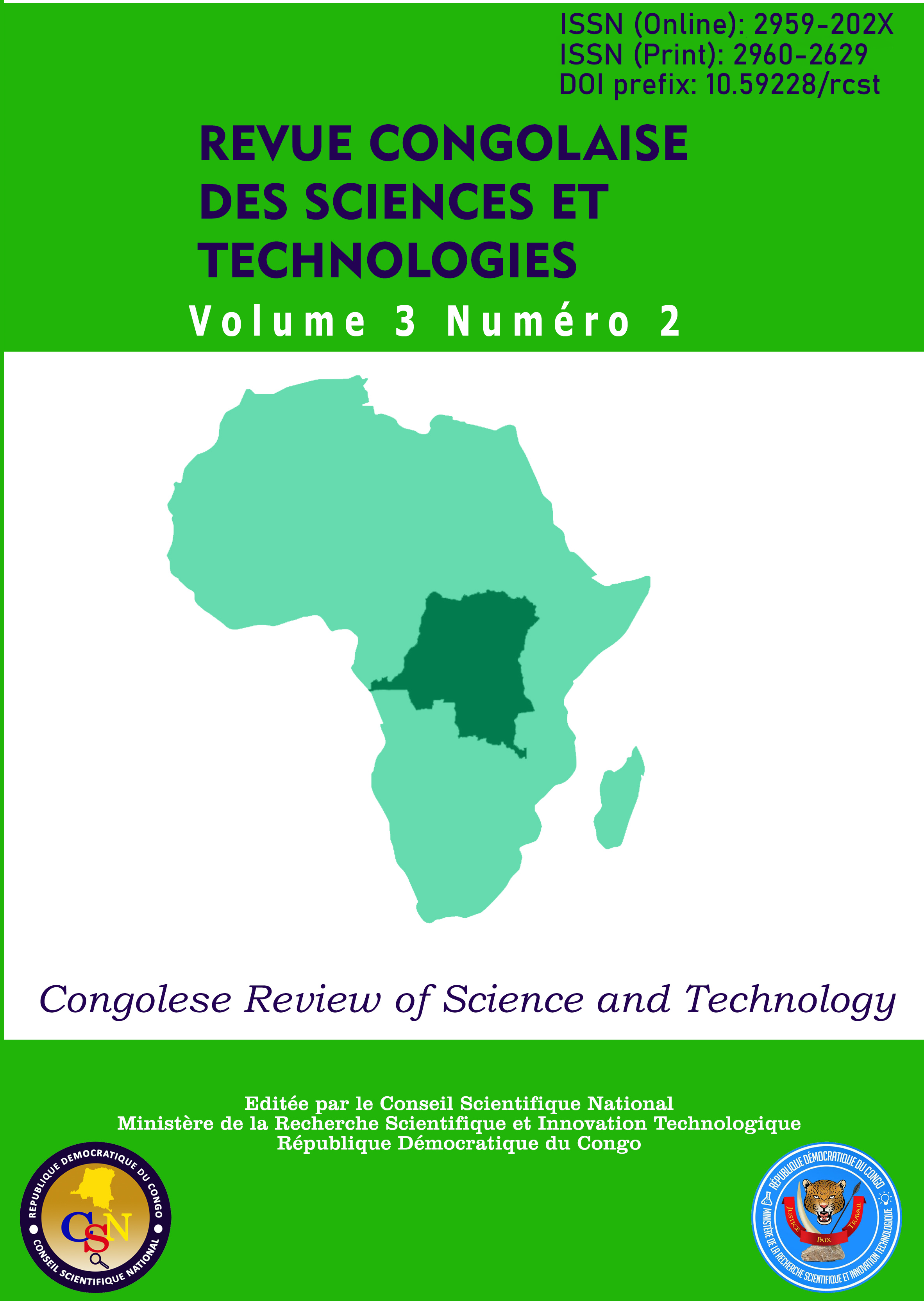Evaluation of the antibacterial activity of Mitragyna stipulosa (DC.) O. (Kuntze, 1891) on Streptococcus pneumoniae (Klein, 1884) Chester, causative agent of Pneumonia
Contenu principal de l'article
Résumé
La pneumonie est l'une des principales causes de décès chez les enfants de moins de cinq ans et une cause majeure de mortalité infantile
dans toutes les régions du monde, la plupart des décès survenant en Afrique subsaharienne et en Asie du Sud. L'agent principal ayant
la prévalence la plus élevée dans les pneumonies graves est, comme son nom l'indique, la bactérie Streptococcus pneumoniae. L'objectif
général de cette étude est d'évaluer l'activité antibactérienne de la décoction des feuilles de Mitragyna stipulosa sur la bactérie S.
pneumoniae par le test de l'antibiogramme, de déterminer la concentration minimale inhibitrice et de comparer l'effet antibactérien de
la décoction par rapport à l'infusion et à la macération, ainsi qu'à l'antibiotique de référence utilisé. Ce travail s'inscrit dans le cadre de
la promotion et de la valorisation de la pharmacopée africaine en général et de la pharmacopée congolaise en particulier, pour venir à
bout d'un problème de santé publique avéré et important.
Details de l'article

Ce travail est disponible sous licence Creative Commons Attribution - Pas d’Utilisation Commerciale - Partage dans les Mêmes Conditions 4.0 International.
Références
Aboaba, O. O., Smith, S. I., & Olude, F. O. (2006).
Antibacterial effect of edible plant extract on
Escherichia coli 0157. Pakistan Journal of
Nutrition, 5(4), 325- 327.
Adjanohoum, J. E., Aké, A. L., Floret, J. J., Guinko,
S., Koumaré, M., Ahyi. A. M., & Raynal. J.
(2001). Médicine traditionnelle et Pharmacopée
Contribution aux études ethnobotaniques et
florestiques au Mali. Paris, ACCT.
Akula, R., & Ravishankar, G. A. (2011). Influence of
abiotic stress signals on secondary metabolites
in plants. Plant Signaling & Behavior, 6(11),
–1731. doi:10.4161/psb.6.11.17613.
Bogaert, D., de Groot, R., & Hermans, P. W. (2004).
Streptococcus pneumoniae colonisation: the key
to pneumococcal disease. Lancet Infect. Dis., 4
(3), 144–154. doi: 10.1016/S1473-
(04)00938-7
Burckhardt, I., Panitz, J., Burckhardt, F., &
Zimmermann, S. (2017). Identification of
Streptococcus pneumoniae: Development of a
Standardized Protocol for Optochin
Susceptibility Testing Using Total Lab
Automation. BioMed Research International, 1–
doi:10.1155/2017/4174168
Celikel, N., & Kavas, G. (2008). Antimicrobial
properties of some essential oils against some
pathogenic microorganisms. Czech Journal of
Food Sciences, 26 (3), 174.
Cohen, R., Levy, C., Bingen, E., Bechet, S., Derkx, V.,
Werner, A., & et al. (2012). Portage
rhinopharyngé d’enfants âgés de six à 60 mois
durant l’implémentation du vaccin
pneumococcique conjugué 13- valent. Arch
Pédiatrie, 19(10), 1132 9.
Dalmarco, J., Dalmarco, E., Koelzer, J., Pizzolatti, M.,
& Fröde, T. (2010). Isolation and identification
of bioactive compounds responsible for the antibacterial efficacy of Lotus corniculatus var. São
Gabriel. Int. J. Green Pharm., (4), 108-114.
Fageyinbo, M. S., Odumeso, A. O., Rotimi, K. I.,
Fasipe, O. J., & Olayemi, S. O. (2018).
Anticonvulsant, anxiolytic and sedative
activities of hydro-ethanolic leaf extract of
Mitragyna stipulosa. Journal of Herbs, Spices &
Medicinal Plants. 25(1), 43–54.
doi:10.1080/10496475.2018.1556373
Fatima, N., Tapondjou, L., Lontsi, D., Sondengam, B.,
Atta-Ur-Rahman, U., & Choudhary, M. (2002).
Quinovic Acid Glycosides From Mitragyna
Stipulosa - First Examples of Natural Inhibitors
of Snake Venom Phosphodiesterase I. NaturalProduct Letters. 16(6), 389–393.
doi:10.1080/10575630290033169
Freney, J. (2007). Précis de bactériologie clinique.
Paris, Éd. Eska
Gong, F., Hai-peng, G., & Qi-tai Xu, W. (2012).
Genus Mitragyna : Ethnomedicinal uses and
pharmacological studies. Phytopharmacology,
(2), 263-272.
Govindappa, M., Bharath, N., Shruthi, H., Sadananda,
T., & Sharanappa, P. (2011). Antimicrobial,
antioxidant and in vitro antiinflammatory
activity and phytochemical screening of
Crotalaria pallida Aiton. Afr. J. Pharm.
Pharmacol., 5(21), 2359-2371.
Janoir, C. (2014). Infections à pneumocoques. EMC -
Mal Infect., 11(3), 1 17.
Jehl, F., Chabaud, A., & Grillon, A. (2015).
L’antibiogramme : diamètres ou CMI ? Journal
Des Anti-Infectieux, 17(4), 125–139.
doi:10.1016/j.antinf.2015.08.003
Karbwang, J., Crawley, F. P., Na-Bangchang, K., &
Maramba-Lazarte, C. (2019). Herbal Medicine
Development: Methodologies, Challenges, and
Issues. Evidence-Based Complementary and
Alternative Medicine. (9), 1–2.
doi:10.1155/2019/4935786
Kumazawa, J., & Yagisawa, M. (2002). The history of
antibiotics: The Japanese story. Journal of
Infection and Chemotherapy, 8(2), 125–133.
doi:10.1007/s101560200022
Linthoingambi, W., & Mutum, S. (2013).
Antimicrobial activities of different solvent
extracts of Tithonia diversifolia (Hemsely) A.
Gray. Asian J. Plant Sci. Res., 3(5), 50-54.
Marimuthu, M., Aruldass, C., Sandrasagaran, U.,
Mohamad, S., Ramanathan, S., Mansor, S., &
Murugaiyah, V. (2014). Antimicrobial activity
and phytochemical screening of various parts of
Ixora coccinea. J. Med. Plants Res. 8(10), 423-
Orihuela, C. J, & Tuomanen, E. I. (2006). Models of
pneumococcal disease. Drug Discov Today Dis
Models., 3(1), 69 75.
Ponce, A., Fritz, R., Del Valle, C., & Roura, S. (2003).
Antimicrobial activity of essential oils on the
native microflora of organic Swiss chard.
Lebensm. Wiss. Technol. (36); 679-684.
Rossi, F., Franco, M., Rodrigues, H., & Andreazzi, D.
(2012). Streptococcus pneumoniae:
sensibilidade a penicilina e moxifloxacina.
Jornal Brasileiro de Pneumologia. 38(1), 66–
doi:10.1590/s1806-37132012000100010
Sandeep, K., Shrivastava, B., Khajuria, R. (2010).
Antimicrobial activity of Crotalaria burhia
Buch.-Ham. Indian J. Nat. Prod. Resour., 1(4),
-484.
Saxena, M., Saxena, J., Nema, R., Singh, D., & Gupta,
A. (2013). Phytochemistry of medicinal plants.Journal of pharmacognosy and phytochemistry,
(6).
Shaki, U., & Soulaymani, B. (2008).
Pharmacovigilance des plantes médicinales.
Rabbat, Centre de Pharmacovigilence du Maroc.
Simell, B., Auranen, K., Käyhty, H., Goldblatt, D.,
Dagan, R., & O’Brien, K. (2012). The
fundamental link between pneumococcal
carriage and disease. Expert Rev. Vaccines, 11
(7), 841–855. doi: 10.1586/erv.12.53
Soussy, C., Bonnet, C., Cavallo, C., Chidiac, C.,
Dubreuil, J., Jehl, L., Leclerc, Lina., Merens, N.,
Plesiat, P., Quentin, V. (2013). Comité de
l’antibiogramme de la société française de
microbiologie, recommandations. Paris, Centre
hospitalier universitaire Henri Mondor.
Wardlaw, T., Emily, W., & Matthew, H. (2006). La
pneumonie de l’enfant : un fléau oublié.
UNICEF/OMS. Paris, Paris.
WHO. (2002). Médecine traditionnelle. (Consulted on
december 2011).
http:www.who.int/mediacentre/factsheets/
/fs134/fr/

